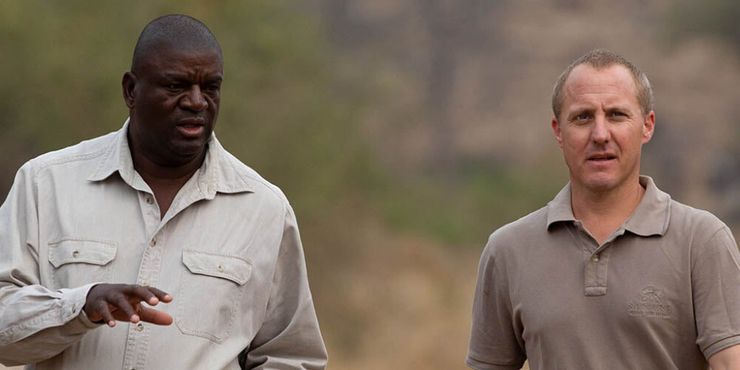The adventures of two wildlife trackers
"Entertaining and inspirational, a fieldguide to life." – Tony Park, bestselling author

World-renowned wildlife trackers Alex van den Heever and Renias Mhlongo have spent more than two decades working together, tracking leopards and lions at Londolozi, jaguars in South America and grizzly bears in the United States. In the book, Alex shares stories from his life with Renias, including the successes, failures, dramas, laughter, disappointments and highlights. As they experience numerous adventures, Alex and Renias learn to trust and rely on one another – both in order to stay alive, in a literal sense because of the sometimes-dangerous environments in which they work, but also to develop a deep and meaningful relationship.
To celebrate the launch of Changing a Leopard's Spots, we've put together an author Q&A with Alex and Renias, featuring questions that came from everyone who attended the virtual launch, including a question from a 10-year-old who loves wildlife.
What does the title of the book refer to?
It makes subtle reference to the fact that one has the ability to change one’s most deep-seated beliefs and behaviours.
There is a lot of intolerance between cultures today, do you think this book can teach us a thing or two beyond tracking and the bush?
Yes, the book demonstrates that once you get beyond broad categorisations and prejudiced thoughts of other people, one’s intolerance dissolves.
What is your most memorable sighting?
Spending time with a leopard on foot while she was hunting. The story is in the book.
What inspired the both of you to become trackers?
It was never a conscious decision. We love being in nature, and tracking is an active and meaningful way to immerse oneself into the life of an animal.
Alex, if Renias had been a younger and less accomplished tracker than you when you first met him, do you believe you could still have established such a balanced relationship and friendship between guide and tracker?
Great question. I think we still would have, but it would have taken longer.
Who of the two of you is better at detail and broad picture?
Alex is better at detail and Renias at the bigger picture.
Alex, you taught Renias English and he taught you Shangaan. Who is the better teacher?
We are both reasonable teachers.
Do you have any advice for those trying to learn a third African language?
Yes, do not let your inhibitions get the better of you. Just start!
For Renias, what has been your most terrifying or closest encounter with an animal while tracking?
Being surrounded by a pride of angry lionesses. And another time, a leopard followed Renias after he found it on foot, which was very unnerving for him!
Have you ever found yourselves in a dangerous situation while tracking an animal?
Yes, several times. If you spend a life pursuing wild animals on foot one ought to have a few stories!
Have you ever been tracked by an animal?
Yes, a bear in Wyoming, in the United State - many years ago. But we escaped.
Alex, what is your scariest sighting with an animal?
An elephant attacked me and two friends on bicycles. My friend’s bike was completely destroyed by the elephant. Fortunately, we all
escaped.
Have you ever tracked in a city environment?
No, we haven’t.
In the face of danger and being attacked, have you used a tranquiliser gun?
We’ve used bear spray and a rifle. But have not shot anything in defence. The more time we spend in nature the less we rely on any form of weapon.
What does it take to become a good tracker?
Thousands of hours of effortful practice. And we are still not there. You never ‘arrive’ as a tracker – there are simply too many variables to be successful all the time.
What is the number one attribute or quality someone needs to become a great tracker, other than experience or practice?
Good observational skills, common sense and compassion for the animal you are tracking.
Renias, where other than Londolozi has your favourite tracking experience been?
Tracking bears in Yellowstone National Park.
What is the hardest animal to track?
Leopard, for sure. But any animal can present a challenge. The soil conditions make it either more difficult or easy.
What is it like tracking an animal and then actually seeing it, how do you feel about it?
It’s a great moment of discovery. Excitement. Especially if you’ve worked hard to find it.
You both have tracked many Leopards in your time. Which Leopard was your favourite to track and why?
The Manghene female leopard at Londolozi, we’ve written a chapter about her in the book.
Are there any key insight from tracking that businesses or leadership teams seem to connect with strongly?
Humans are born trackers. We are all tracking the weather, each other, stocks and clients – all the time. Business leaders can learn from wildlife trackers how to track more effectively. Visit our blog to learn more about our talk and how tracking links to business.
What two or three things do you advise your tracking students to do when they lose the track?
Slow down. Go back to your last known clear track. Think about what the animal is doing, and move forward with extra vigilance. Try to imagine which route the animal may have taken. Let the terrain guide you.
Many trackers started as young boys in the villages. Are there many female trackers coming into the industry?
There are not many. But that could be as a result of fewer opportunities for female trackers. Tracker Academy had begun enrolling female trackers.
Why a Leopard? And what is the longest ‘Tracking’ period of time that you have both done in Africa?
Leopards tread very lightly on the ground. They have soft and small feet. They also move in seemingly unpredictable directions. We once tracked a white rhino for 16 hours and found it.
How much knowledge does a tracker need to know about the fauna and flora in general?
A tracker must develop sound ecological literacy. That means having an above average knowledge of all nature’s components.
Do you think there is a positive place for technology in the future of tracking, that can assist with preserving the value of this ancient art (for example, through storytelling and making tracking more accessible)?
Yes, definitely. Technology allows us to scale-up the access to indigenous knowledge.
What opportunities do you have to link your network of trackers to the ‘middle or junior’ staff of corporates that cannot travel to expensive bush excursions?
Yes, EcoTraining offers short courses in tracking run by Tracker Academy courses.
With all your experience, what should a field guide bring to the Bush? What can we do to educate and protect the wildlife?
The Tracker Manual field guide. Teach children to respect nature as an equal.
What are some of the superstitions about tracking you've heard, for example, not pointing at a track with the index finger – are there any others?
Nope. We try not to walk on top of animal tracks, but that is mostly to avoid destroying evidence that we may need later in the trail.
The relationship and rapport between guide and tracker has a huge impact on the guest experience. How have your guests witnessed this?
Yes, I hope so! We have guests that Renias and I continue to take on safari each year, that come mostly because they enjoy our company. We have taken a couple from New York on safari every year since 1995. It is true that a sound guide-tracker relationship is vital to a great safari experience.
For a typical South African with a typical budget, where or how does one go about witnessing some of these great trackers? It seems like they are at the exclusive camps and resorts.
Some of the Kruger Park trails have excellent trackers. EcoTraining also offers tracker training courses where Renias and other top graduates of the Tracker Academy teach lessons.
Alex, with the tracker market, do the lodges around Africa value the tracking expertise and are the trackers moving out of the academy being employed easily into lodges?
Over 90% of Tracker Academy’s graduates are finding employment. More and more lodges are turning to the services of trackers in some form – either to find elusive animals, monitor animals or for anti-poaching efforts.
How do you see the future for wildlife tourism in South Africa after corona virus eases?
We are going to see a drop in international travel in the short and medium term, which will negatively impact the lives of many people who make a living from ecotourism. The result may be more local travel, which is a good thing.
Your thoughts with putting collars on animals?
Not particularly something I favour. But I understand that it is sometimes necessary for protection in areas where poaching is high risk.
Do wolves and painted dogs have similar behavioural characteristics?
Yes, they do. They move large distances very quickly. The tracker must make extensive use of anticipation in order to successfully find them.
Is it possible to habituate a leopard to people for viewing purposes and is this something that can be done short to medium term?
Yes, we have conducted several leopard habituations projects, with good results. It takes 1 to 3 years of consistent tracking and relationship-building to habituate a leopard.
Do you think it is a good book for a child to read?
Yes, it’s perfect for you.
Is there a specific place or animal which the both of you desire to track or see?
Tigers in India!
If you missed the virtual launch, watch it Alex and Renias in discussion with James Hendry, wildlife presenter and bestselling author:
Alex van den Heever is currently the general manager of the Tracker Academy, an NGO that trains people in the traditional skills of tracking, and is also director and shareholder of EcoTraining, the largest privately owned guide training school in Africa. Renias Mhlongo has spent 37 years working as a guide, tracker and trainer and has accumulated thousands of hours tracking big game on foot at Londolozi Game Reserve and in wildlife areas around the world. Alex and Renias conduct their motivational presentation, ‘The Power of Relationships’, across Africa and overseas. They are co-authors, together with Karel Benadie, of the bestselling animal tracking field guide, Tracker Manual.

